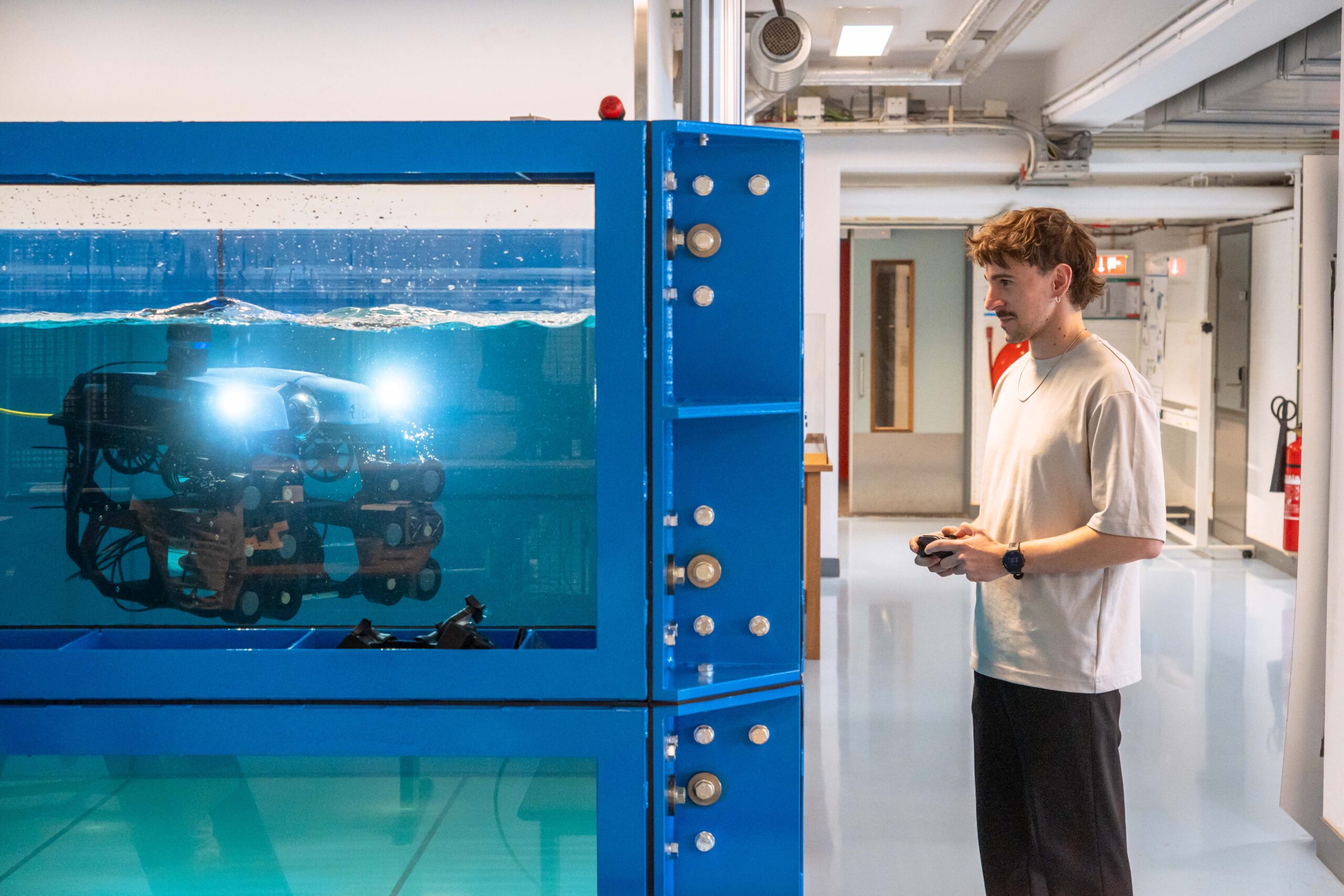In collaboration with the offshore industry, TU Delft researchers are developing a system that can remotely monitor the condition of anchor chains. With the increasing number of floating energy platforms, this is becoming more important than ever.
Filippo Riccioli attached the ultrasound sensors to the large ROV for underwater testing in the Atlantic Ocean. (Photo: Private collection)
When PhD student Filippo Riccioli set off from Rio de Janeiro last month, he first had to get used to the slow rocking of the Atlantic Ocean. Alongside his laptop, he had packed ultrasound sensors in his flight cases. His aim was to record underwater sound – not the songs of whales or the clicks of dolphins, but a kind of metallic chirping in the 100 to 400 kilohertz range, far beyond what humans can hear. But first, he faced a half-day voyage over an undulating blue expanse, until his vessel docked alongside a large work ship (Floating Production Storage and Offloading unit) used to anchor offshore platforms. That would be Riccioli’s home for the coming weeks.
Riccioli belongs to a team of researchers at the TU Delft Faculty of Mechanical Engineering led by Dr Pooria Pahlavan. They are working on a new way to monitor anchor chains – not with cameras or divers, but by listening to the chains with ultrasound sensors.
Metal fatigue and corrosion
As the energy sector shifts towards sustainability, more and more floating wind turbines, solar arrays, and storage platforms are appearing. Most of these are anchored to the seabed with massive iron chains. While they may seem indestructible, time and saltwater gradually wear them down. In the end, they succumb to metal fatigue, corrosion, or both.
Because of safety issues for people and equipment, these anchor chains – sometimes kilometres long – must be inspected every year. This can be done visually, but only after removing all marine growth. Another method is to measure the diameter of the chain links, the reduction compared to their original size gives an indication of wear and corrosion. In any case, inspecting anchor chains is a time-consuming and labour-intensive task – one that’s ripe for improvement.
‘Changes to the metal surface give off specific ultrasound signals’
Wrist-thick links
Previously, Riccioli, under the supervision of dr. Pooria Pahlavan from the Ship and Offshore Structures section (Faculty of Mechanical Engineering), conducted research at a laboratory of the DNV Norwegian maritime classification society. There, a segment of anchor chain – five wrist-thick links – was placed in a tensile testing rig under seawater. Riccioli positioned movable underwater panels with ultrasound sensors next to it.
“Changes to the metal surface give off specific ultrasound signals,” Riccioli explains. “We can distinguish between the signal from a flake of rust breaking off and the signal from a microscopic crack spreading through the material. They produce different acoustic emissions.”
Would acoustic emission detection also work in the real world, amid ocean swells, rattling winches, marine life and churning propellers?
You can picture a kind of ‘chain whisperer’ – someone who detects signals no one else notices. With their ultrasound sensors, Riccioli and co-authors from TU Delft, DNV and Equinor ASA were able to acoustically distinguish the two main degradation mechanisms in anchor chains: seawater corrosion and fatigue from the ocean’s endless motion. It’s worth noting that this testing lasted for weeks or even months. An anchor chain is a hefty bit of kit.
By placing multiple sensors at right angles, they were also able to pinpoint the origin of the ultrasound signals. This was the main finding of an article published last year in Marine Structures by Riccioli with Dr Pooria Pahlavan, his supervisor, as lead researcher.
Chain Reaction
But would acoustic emission detection also work in the real world, amid ocean swells, rattling winches, jangling chains, marine life, roaring engines, and churning propellers? To find out, Riccioli boarded the immense AHTS (Anchor Handling Tug Supply) vessel. At TU Delft’s test tank, he works with an underwater robot the size of a beer crate. There, the robot was a four tonne remotely operated vehicle (ROV) measuring two by one-and-a-half metres. It could perform a range of tasks at depths of up to two kilometres, but for this experiment, it only had to hover near an anchor chain.
In his first days on board, Riccioli assembled a panel of ultrasound sensors behind a stainless-steel protective frame to mount on the ROV. “We built a solid steel cage to shield the sensors. There were all kinds of operations underway, but eventually we were given access to the ROV for a few days. We headed to the control room, which was full of monitors, and deployed the ROV from there. It descended to a depth of 30 metres, and once the crane released it, we could start piloting it ourselves.”
“Underwater, we saw the anchor chains of our own ship. We picked one and manoeuvred the robot to hover just a few metres away. It had to stay perfectly still. This was the moment I had come for: would we be able to pick up acoustic emissions under real-world conditions?”
‘The signals resembled those we’d seen in the lab for corrosion’
A week after returning to TU Delft, I meet Riccioli in the Researchlab Autonomous Shipping (RAS). His eyes light up as he recounts the experience. But did it work? “Yeah, the background acoustic noise due to underwater operations did not interfere with the measurements of the acoustic emissions, possibly resembling those we’d seen in the lab for corrosion.”
So far, Riccioli has not yet detected signs of expanding cracks caused by metal fatigue. “But the data analysis is still ongoing.” He will present the results of the field test in June at a meeting of the Floating Energy Research Forum (FER) forum at MARIN in Wageningen.
Floating Robots
The researchers envision a future where underwater robots autonomously inspect anchor chains. At the moment, each inspection takes a while – think of an hour hovering to ‘listen’ to several metres of chain at a time. The process would be a bit like painting the Eiffel Tower: by the time you finish at the top, it’s time to start again at the bottom.
According to Riccioli and his colleagues, ultrasonic inspection could become a big step forward compared to current practices – especially for the offshore energy industry which is currently growing rapidly. The FERF meeting should reveal how the industry itself feels about the potential.

- The research team will present the results of the field test at a meeting of the Floating Energy Research (FER) Forum at Marin in Wageningen (16-20 June 2025).
- The TU Delft Donut JIP (Digital twin of mooring systems using ultrasound measurements) project led by dr. Pahlavan is one of the topics at the meeting.
Do you have a question or comment about this article?
j.w.wassink@tudelft.nl


Comments are closed.